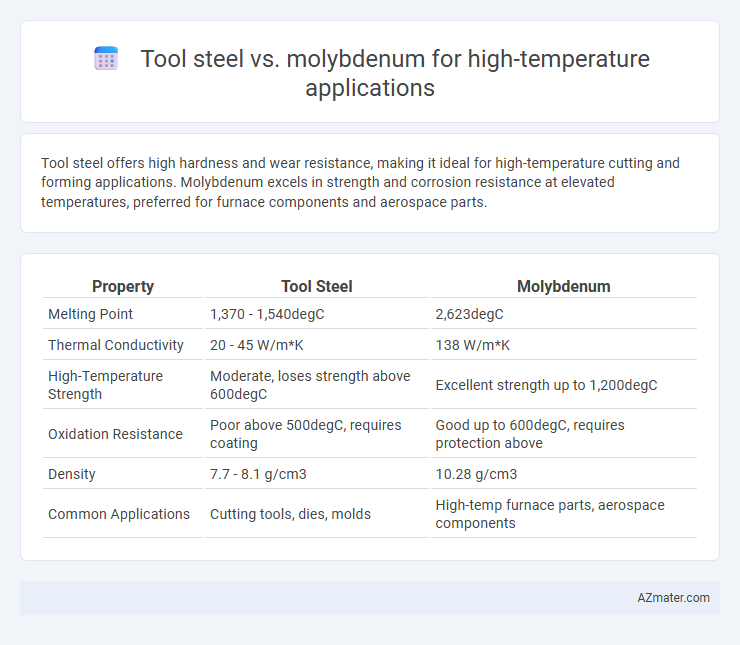Tool steel offers high hardness and wear resistance, making it ideal for high-temperature cutting and forming applications. Molybdenum excels in strength and corrosion resistance at elevated temperatures, preferred for furnace components and aerospace parts.
Table of Comparison
| Property | Tool Steel | Molybdenum |
|---|---|---|
| Melting Point | 1,370 - 1,540degC | 2,623degC |
| Thermal Conductivity | 20 - 45 W/m*K | 138 W/m*K |
| High-Temperature Strength | Moderate, loses strength above 600degC | Excellent strength up to 1,200degC |
| Oxidation Resistance | Poor above 500degC, requires coating | Good up to 600degC, requires protection above |
| Density | 7.7 - 8.1 g/cm3 | 10.28 g/cm3 |
| Common Applications | Cutting tools, dies, molds | High-temp furnace parts, aerospace components |
Introduction to High-Temperature Engineering Materials
High-temperature engineering materials must exhibit exceptional thermal stability, oxidation resistance, and mechanical strength to perform reliably under extreme conditions. Tool steel, enriched with elements like tungsten and chromium, provides excellent hardness and wear resistance but generally has limited performance above 600degC. Molybdenum, with its high melting point of 2,623degC and superior creep resistance, offers enhanced durability and oxidation resistance at elevated temperatures, making it more suitable for applications requiring prolonged exposure to extreme heat.
Defining Tool Steel: Composition and Key Properties
Tool steel is a high-performance alloy composed primarily of carbon along with elements such as chromium, vanadium, tungsten, and molybdenum, designed for exceptional hardness, wear resistance, and heat resistance in high-temperature applications. Its microstructure typically includes carbides that enhance durability and maintain strength under thermal stress, making it suitable for cutting, molding, and forming tools exposed to intense heat. Key properties of tool steel include high thermal stability, excellent toughness, and the ability to retain hardness above 200degC, critical for maintaining performance in elevated temperature environments.
Understanding Molybdenum: Characteristics and Uses
Molybdenum's high melting point of 2,623degC (4,753degF) and excellent thermal conductivity make it ideal for high-temperature applications where tool steel may fail due to lower heat resistance. Its low coefficient of thermal expansion and superior strength at elevated temperatures ensure stability and durability in demanding environments such as aerospace, furnace components, and electrical contacts. Unlike tool steel, molybdenum resists oxidation and deformation under extreme heat, enhancing performance and lifespan in thermal-critical conditions.
Performance of Tool Steel at Elevated Temperatures
Tool steel exhibits exceptional wear resistance and hardness retention at elevated temperatures, making it a reliable choice for high-temperature applications such as die casting and hot forging. Its microstructure, often enhanced by alloying elements like chromium and vanadium, provides superior thermal stability and strength beyond 500degC (932degF). Compared to molybdenum, tool steel maintains better dimensional stability and toughness under cyclic thermal loading, ensuring prolonged tool life and consistent performance in harsh environments.
Molybdenum’s Behavior in High-Temperature Environments
Molybdenum exhibits exceptional high-temperature strength and stability, outperforming many traditional tool steels by maintaining structural integrity beyond 1,000degC. Its low thermal expansion and excellent creep resistance make it ideal for environments with intense thermal cycling. Unlike conventional tool steels that can soften or oxidize at elevated temperatures, molybdenum retains hardness and resists wear, ensuring superior performance in aerospace and industrial furnace applications.
Comparative Analysis: Tool Steel vs. Molybdenum Thermal Stability
Tool steel exhibits good thermal stability up to approximately 500degC, but its hardness and strength degrade significantly beyond this range due to oxidation and microstructural changes. Molybdenum offers superior thermal stability, maintaining mechanical properties at temperatures exceeding 1000degC, making it ideal for high-temperature applications such as aerospace and industrial furnaces. The higher melting point (2623degC) and excellent oxidation resistance of molybdenum provide advantages over tool steel, which typically melts around 1370-1510degC depending on alloy composition.
Oxidation Resistance: A Critical Factor in Material Selection
Tool steel often exhibits moderate oxidation resistance at high temperatures, limiting its performance in extreme thermal environments. Molybdenum excels with superior oxidation resistance due to its stable oxide layer formation, enabling prolonged durability in applications exceeding 1000degC. Selecting molybdenum over tool steel enhances longevity and reliability in high-temperature oxidation-prone settings.
Mechanical Strength and Creep Resistance Comparison
Tool steel, specifically grades like H13, offers excellent mechanical strength and hardness at elevated temperatures, but its creep resistance is limited beyond 550degC. Molybdenum exhibits superior creep resistance and retains mechanical strength at temperatures exceeding 1000degC due to its high melting point and stable microstructure. For high-temperature applications requiring prolonged stress resistance, molybdenum outperforms standard tool steels in maintaining structural integrity under thermal creep conditions.
Cost-Efficiency and Availability for Industrial Applications
Tool steel offers a cost-efficient solution for high-temperature applications due to its widespread availability and established manufacturing processes, making it a preferred choice in many industrial settings. Molybdenum, while more expensive, provides superior high-temperature strength and corrosion resistance, which can lead to longer service life and reduced maintenance costs in critical applications. Industrial decision-making balances molybdenum's higher material cost against tool steel's accessibility and overall cost-effectiveness, depending on the specific temperature demands and operational conditions.
Selecting the Right Material: Application-Based Recommendations
Tool steel offers excellent hardness and wear resistance for high-temperature applications requiring superior strength and durability, especially in cutting and forming tools. Molybdenum excels in environments with extreme heat and corrosion, providing exceptional thermal stability and oxidation resistance, making it ideal for aerospace and chemical processing industries. Selecting the right material depends on specific application requirements such as temperature range, mechanical stress, and exposure to corrosive elements to ensure optimal performance and longevity.

Infographic: Tool steel vs Molybdenum for High-temperature application
 azmater.com
azmater.com